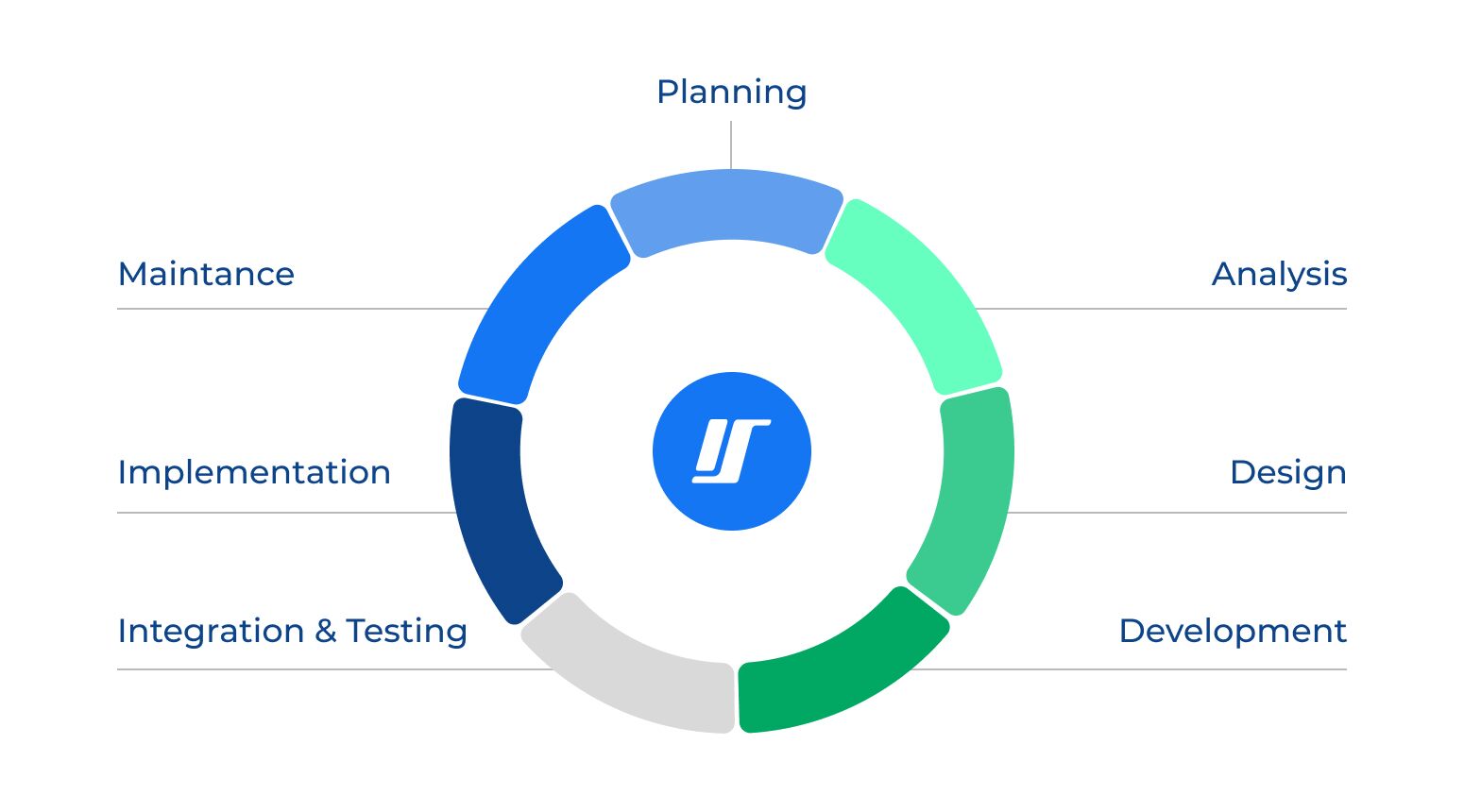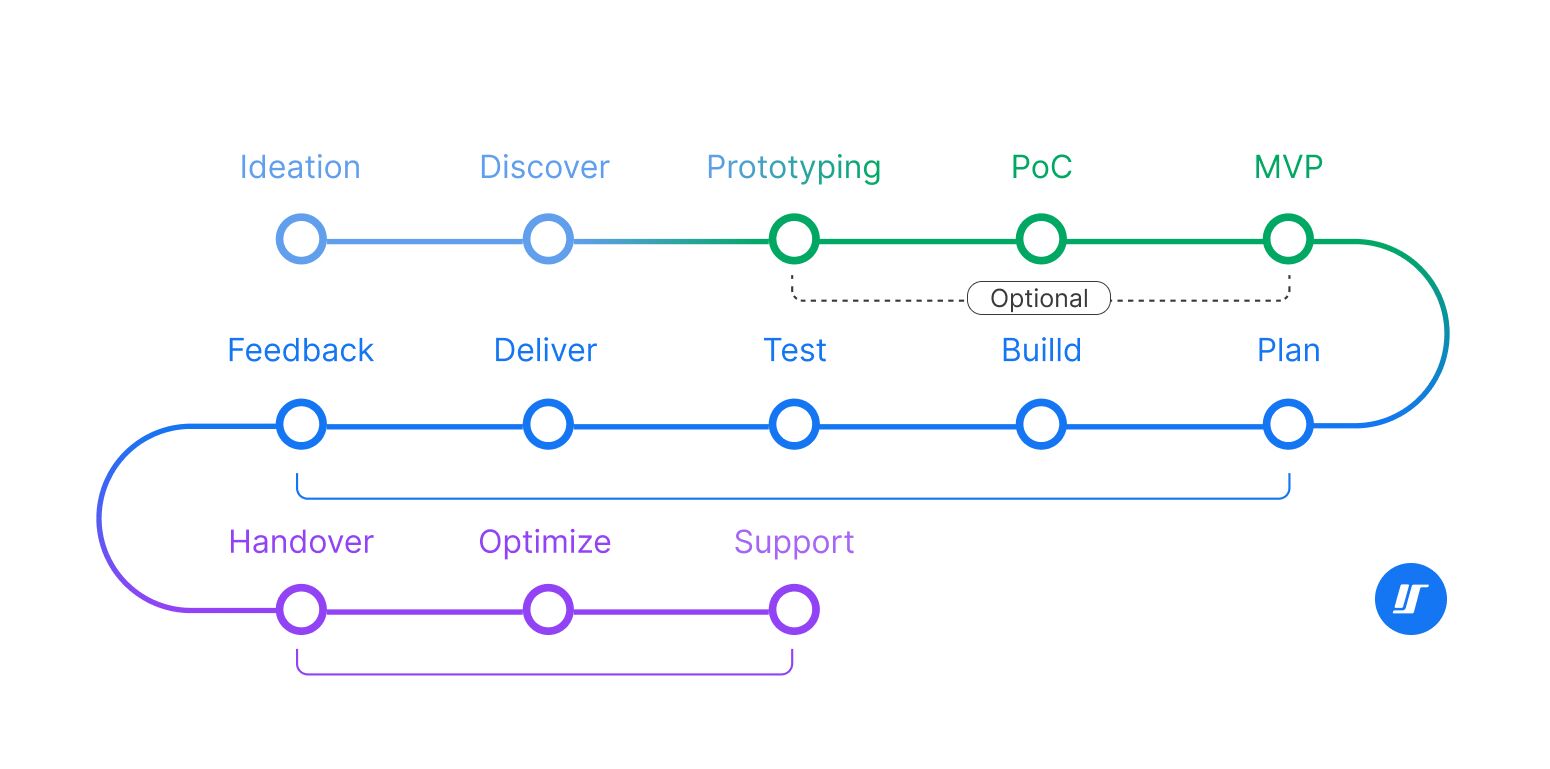

Steve Jobs once said, "The journey is the reward." And when it comes to software product and software development projects, that journey is exciting but can be tricky. Whether you're a founder, executive, or product manager involved in the software development process, you'll likely see your ideas evolve as the project progresses. Jobs warned that having a great idea is just the start—the real challenge is making it all come together. And the key here is to test your ideas and find what works best for your market and customers.
To bring your vision to life, it’s important to partner with the right dedicated team and follow a solid software development process. In this article, we’ll walk you through the key steps we use at Intellectsoft, from choosing the right methodology to managing your project and finding the right team. Let’s dive in!
Basically, software product development is the process of bringing a new product to market for your customers or users. It covers every stage from the very beginning—ideation and planning (brainstorming/workshops) to launching and maintaining the final product. Typically, it starts with workshop sessions between your internal team and your tech partner.
It’s worth mentioning that many companies differentiate between SDLC and the Software Development Process. At Intellectsoft, we use them interchangeably.
A standard SDLC involves seven stages: Planning, Analysis, Design, Development, Integration & Testing, Implementation, and Maintenance. You might come across different terms for these stages, but they all follow the same flow.

The process we use at Intellectsoft is a more extended version of this, which we’ll dive into in the next section.
Before diving into the software development process, it’s important to start by clearly defining your business objectives. Think of this as your foundation — making sure everything lines up with your overall business goals.
Now, let’s see what process we use at Intellectsoft. As a tech partner, we’ve developed our well-developed software roadmap, which we follow with our clients. These steps help ensure a smooth and successful journey from the initial planning usability testing stage all the way to the final rollout.

Ideation phase can happen on the client’s side, often through brainstorming sessions with their in-house team. Alternatively, it can occur during the Discovery phase, where we help refine and add depth to the idea. This stage ensures your concept is fully developed and ready to move into the next phase of the project.
Our discovery phase starts with a series of workshops with your team. These sessions help us gather all the details to create custom, software solution that fits your business. During this phase, we map out the architecture, craft a solid strategy, keep risks and budget in mind, and present a clear development roadmap.
In this stage, we translate your business requirements into a software design. We create prototypes to give you a preview of how the final product will function.
We create a POC to test whether the concept is technically feasible. It’s a quick and efficient way to ensure the idea can work in the real world, helping us avoid the risks later on.
At your request, we can build an MVP — a simplified version of the software with core features. This allows us to gather your feedback early, make quick improvements, and ensure we’re on the right track.
*Prototype, PoC, and MVP stages are optional. For smaller projects or when the requirements are clear and well-defined, you can proceed directly to development.
With all the information in hand, we finalize the development roadmap. This includes setting clear timelines, assigning resources, and locking in the budget.
Our development team gets straight to work, coding your software using the technology and methods we agreed on, ensuring everything is built to the highest standard.
Once the software is built, we run it through thorough testing. We check for bugs, ensure usability, and confirm the software meets all the goals we set at the start.
Now comes the exciting part—launching! We carefully release your software into your IT environment, ensuring everything runs smoothly. We’ll also be there to handle any last-minute issues and share best practices with your team.
At this post-launch stage we take a look at user feedback and make any necessary adjustments. This phase is about polishing the product and making improvements to ensure it’s working seamlessly.
This is a phase between Development and Support. The handover can either signal the end of the development team's involvement (handover and exit) or lead to ongoing support, optimization, and maintenance, depending on the project agreement in the beginning.
We provide ongoing maintenance, offering updates, introducing new features, and keeping your system running.
As your business evolves, so will your software. We’ll continue to optimize it over time, improving performance and making updates that keep everything aligned with your changing needs.
Whether it’s answering questions or providing assistance, we offer full support to ensure your software continues to serve you well.
Adopting a structured approach to software development is a powerful way to streamline your projects and save resources. It creates a clear roadmap that turns even the most complex tasks into manageable steps.
Let’s dive into the key benefits that a structured approach brings to the table:
Making Complex Projects Simpler
A structured approach breaks big projects into manageable steps, making everything easier to handle with focus and clarity.
Clear Goals and Problem-Solving
With a clear process in place, you’ll understand your goals and challenges better, keeping everything on track and precise.
Better Clarity and Control
Each step is approved before moving forward, giving everyone a clear path and keeping the project manager in full control.
Thorough Testing Before Launch
Built-in checkpoints ensure everything is tested before launch, reducing risks and ensuring a smooth rollout.
Easy Onboarding for New Team Members
With detailed documentation, new team members can quickly step in and pick up where others left off without missing a beat.
Smarter Budget and Time Management
With clear timelines and budgets, project managers can focus on getting things done efficiently, with tools that keep tasks on track.
Continuous Improvement
Agile models allow for ongoing feedback, letting the project improve and evolve until it’s just right.
Fewer Issues, More Control
A structured approach minimizes problems and keeps the project manager focused on the bigger picture with total control.
For mobile apps, it’s important to define:
In mobile app development, these factors are relevant:
Apps rely heavily on backend infrastructure:
Mobile apps often handle sensitive data (e.g., user profiles, payment details). Key considerations to have in mind:
Mobile apps require consistent updates for:
Planning ahead for scalability, security, and regular updates is key to building a budget that supports both the app’s launch and its long-term success, ultimately affecting the final app development cost.
Building a mobile app is a game-changer for businesses looking to deliver value to their customers and stay competitive. But when it comes to cost, there’s no universal answer. The price of mobile app development depends on a variety of factors—like the app’s purpose, complexity, platforms (iOS, Android, or both), and the level of features.
If you’re planning to develop a simple app, prototype, or MVP, the costs will be significantly different from building a feature-rich app with advanced functionalities like AI, AR, or real-time data processing.
Long-term considerations like regular updates, scalability, and security should also factor into your budget.

The SaaS application development industry is experiencing remarkable growth, with the market reaching $317.55 billion in 2024, up from $273.55 bill...

Thinking about having an efficient and high-performing mobile app for your business? Always a smart move. A well-built app can drive real value for...

The SaaS application development industry is experiencing remarkable growth, with the market reaching $317.55 billion in 2024, up from $273.55 bill...

The SaaS application development industry is experiencing remarkable growth, with the market reaching $317.55 billion in 2024, up from $273.55 bill...

Steve Jobs once said, "The journey is the reward." And when it comes to software product and software development projects, that journey is excitin...

Thinking about having an efficient and high-performing mobile app for your business? Always a smart move. A well-built app can drive real value for...

The SaaS application development industry is experiencing remarkable growth, with the market reaching $317.55 billion in 2024, up from $273.55 bill...

The SaaS application development industry is experiencing remarkable growth, with the market reaching $317.55 billion in 2024, up from $273.55 bill...

Steve Jobs once said, "The journey is the reward." And when it comes to software product and software development projects, that journey is excitin...

Thinking about having an efficient and high-performing mobile app for your business? Always a smart move. A well-built app can drive real value for...

The SaaS application development industry is experiencing remarkable growth, with the market reaching $317.55 billion in 2024, up from $273.55 bill...

The SaaS application development industry is experiencing remarkable growth, with the market reaching $317.55 billion in 2024, up from $273.55 bill...

Steve Jobs once said, "The journey is the reward." And when it comes to software product and software development projects, that journey is excitin...

Thinking about having an efficient and high-performing mobile app for your business? Always a smart move. A well-built app can drive real value for...

The SaaS application development industry is experiencing remarkable growth, with the market reaching $317.55 billion in 2024, up from $273.55 bill...

Steve Jobs once said, "The journey is the reward." And when it comes to software product and software development projects, that journey is excitin...

Thinking about having an efficient and high-performing mobile app for your business? Always a smart move. A well-built app can drive real value for...

The SaaS application development industry is experiencing remarkable growth, with the market reaching $317.55 billion in 2024, up from $273.55 bill...

Steve Jobs once said, "The journey is the reward." And when it comes to software product and software development projects, that journey is excitin...

Thinking about having an efficient and high-performing mobile app for your business? Always a smart move. A well-built app can drive real value for...

The SaaS application development industry is experiencing remarkable growth, with the market reaching $317.55 billion in 2024, up from $273.55 bill...

Steve Jobs once said, "The journey is the reward." And when it comes to software product and software development projects, that journey is excitin...

Thinking about having an efficient and high-performing mobile app for your business? Always a smart move. A well-built app can drive real value for...

The SaaS application development industry is experiencing remarkable growth, with the market reaching $317.55 billion in 2024, up from $273.55 bill...

For cooperation not related to the services we provide, contact us at [email protected].

Get Started Today.
Let’s discuss your ideas. We will send you an NDA before we talk.
 All
the information is kept confidential.
All
the information is kept confidential.














